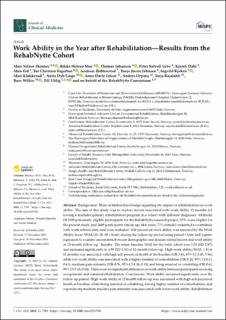| dc.description.abstract | Background: There is limited knowledge regarding the impact of rehabilitation on work ability. The aim of this study was to explore factors associated with work ability 12 months fol- lowing a multidisciplinary rehabilitation program in a cohort with different diagnoses. Methods: Of 9108 potentially eligible participants for the RehabNytte research project, 3731 were eligible for the present study, and 2649 participants (mean age 48.6 years, 71% female) consented to contribute with work-related data, and were included. Self-perceived work ability was assessed by the Work Ability Score (WAS) (0–10, 10 = best), during the follow-up period using paired t-tests and logistic regression to examine associations between demographic and disease-related factors and work ability at 12-month follow-up. Results: The mean baseline WAS for the total cohort was 3.53 (SD 2.97), and increased significantly to 4.59 (SD 3.31) at 12-month follow-up. High work ability (WAS ≥ 8) at 12 months was associated with high self-perceived health at the baseline (OR 3.83, 95% CI 2.45, 5.96), while low work ability was associated with a higher number of comorbidities (OR 0.26, 95% CI 0.11, 0.61), medium pain intensity (OR 0.56, 95% CI 0.38, 0.83) and being married or cohabiting (OR 0.61, 95% CI 0.43, 0.88). There were no significant differences in work ability between participants receiving occupational and standard rehabilitation. Conclusions: Work ability increased significantly over the follow-up period. High work ability at 12-month follow-up was associated with high self-perceived health at baseline, while being married or cohabiting, having higher number of comorbidities, and experiencing medium baseline pain intensity was associated with lower work ability. Rehabilitation interventions targeting these factors may potentially enhance work ability, leading to a positive impact on work participation among people in need of rehabilitation. | en_US |

